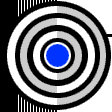|
September 27, 2002
|
|
 |
 |
|
Polar structures induce resistance to cell death, part 2 |
||
| Contact: Paul Preuss, paul_preuss@lbl.gov | ||
|
|
The dynamics of tissue structure Weaver, Bissell, and their colleagues report that when certain receptor proteins in the cell membranes, called a6 and ß4 integrins, latch onto basement-membrane proteins called laminins, they trigger the formation of protein complexes (hemidesmosomes), which fasten the cell's internal skeleton to the basement membrane.
This firm attachment is correlated with the formation of polar structures. At the same time, a protein called NFkB -- a member of the important class of proteins known as transcription factors -- is activated inside the cells. NFkB is a central player in protecting cells against death stimuli, including the action of many anticancer drugs and the body's immune system as well. "The molecular pathway by which tumors become resistant is the same molecular pathway that creates polarity, the organization of three-dimensional spheroids," Weaver says. "The mechanism is the same." Many clinical results are easier to understand when tissue polarization
is taken into account. For example, breast cancer patients who express
excessive amounts of laminins and ß4 integrins -- signs that the
architecture of their tumors is conveying resistance to apoptosis -- have
the poorest prognosis. "You need only ten percent of the cells in a tumor to be drug resistant to be in danger of defeating chemotherapy," says Weaver.
"Even if you kill all the others, these islands remain, and the cancer may start growing again and spread." Bissell adds "This underlines the importance of the extracellular matrix and the basement membrane -- in this case, too much basement membrane is as bad as too little." The new results have important ramifications for testing new anticancer drugs. One way is through examining the role of polar structures in other kinds of drug resistance and cancer cell migration. Another is testing new drugs. "It's easy to forget, when growing cells in culture, that structure has significance," Bissell says. "You can't test new cancer drugs in humans, but to test them only in 2-D is foolish." "ß4 integrin-dependent formation of polarized three-dimensional
architecture confers resistance to apoptosis in normal and malignant mammary
epithelium," by Valerie M. Weaver, Sophie Lelièvre, Jonathan
N. Lakins, Micah A. Chrenek, Jonathan C. R. Jones, Filippo Giancotti,
Zena Werb, and Mina J. Bissell, appeared in Cancer Cell, September
2002, vol. 2. Additional information
|
||||||||||||||||||||||||